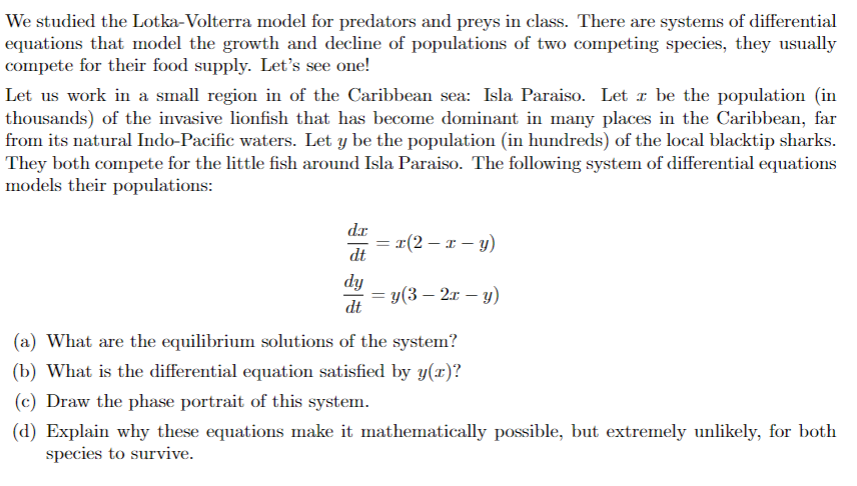We studied the Lotka-Volterra model for predators and preys in class. There are systems of differential equations that model the growth and decline of populations of two competing species, they usually compete for their food supply. Let's see one! Let us work in a small region in of the Caribbean sea: Isla Paraiso. Let z be the population (in thousands) of the invasive lionfish that has become dominant in many places in the Caribbean, far from its natural Indo-Pacific waters. Let y be the population (in hundreds) of the local blacktip sharks. They both compete for the little fish around Isla Paraiso. The following system of differential equations models their populations: dr dt dy dt = x(2 - x - y) = y(3-2x - y) (a) What are the equilibrium solutions of the system? (b) What is the differential equation satisfied by y(r)? (c) Draw the phase portrait of this system.
We studied the Lotka-Volterra model for predators and preys in class. There are systems of differential equations that model the growth and decline of populations of two competing species, they usually compete for their food supply. Let's see one! Let us work in a small region in of the Caribbean sea: Isla Paraiso. Let z be the population (in thousands) of the invasive lionfish that has become dominant in many places in the Caribbean, far from its natural Indo-Pacific waters. Let y be the population (in hundreds) of the local blacktip sharks. They both compete for the little fish around Isla Paraiso. The following system of differential equations models their populations: dr dt dy dt = x(2 - x - y) = y(3-2x - y) (a) What are the equilibrium solutions of the system? (b) What is the differential equation satisfied by y(r)? (c) Draw the phase portrait of this system.
Linear Algebra: A Modern Introduction
4th Edition
ISBN:9781285463247
Author:David Poole
Publisher:David Poole
Chapter2: Systems Of Linear Equations
Section2.4: Applications
Problem 16EQ
Related questions
Question
May I ask for the d part of this question? Please explain and answer it in clear writing. Thank you!

Transcribed Image Text:We studied the Lotka-Volterra model for predators and preys in class. There are systems of differential
equations that model the growth and decline of populations of two competing species, they usually
compete for their food supply. Let's see one!
Let us work in a small region in of the Caribbean sea: Isla Paraiso. Let z be the population (in
thousands) of the invasive lionfish that has become dominant in many places in the Caribbean, far
from its natural Indo-Pacific waters. Let y be the population (in hundreds) of the local blacktip sharks.
They both compete for the little fish around Isla Paraiso. The following system of differential equations
models their populations:
dr
dt
dy
dt
= x(2 - x - y)
= y(3-2x - y)
(a) What are the equilibrium solutions of the system?
(b) What is the differential equation satisfied by y(x)?
(c) Draw the phase portrait of this system.
(d) Explain why these equations make it mathematically possible, but extremely unlikely, for both
species to survive.
Expert Solution
This question has been solved!
Explore an expertly crafted, step-by-step solution for a thorough understanding of key concepts.
Step by step
Solved in 3 steps with 1 images

Recommended textbooks for you

Linear Algebra: A Modern Introduction
Algebra
ISBN:
9781285463247
Author:
David Poole
Publisher:
Cengage Learning

College Algebra (MindTap Course List)
Algebra
ISBN:
9781305652231
Author:
R. David Gustafson, Jeff Hughes
Publisher:
Cengage Learning

Linear Algebra: A Modern Introduction
Algebra
ISBN:
9781285463247
Author:
David Poole
Publisher:
Cengage Learning

College Algebra (MindTap Course List)
Algebra
ISBN:
9781305652231
Author:
R. David Gustafson, Jeff Hughes
Publisher:
Cengage Learning